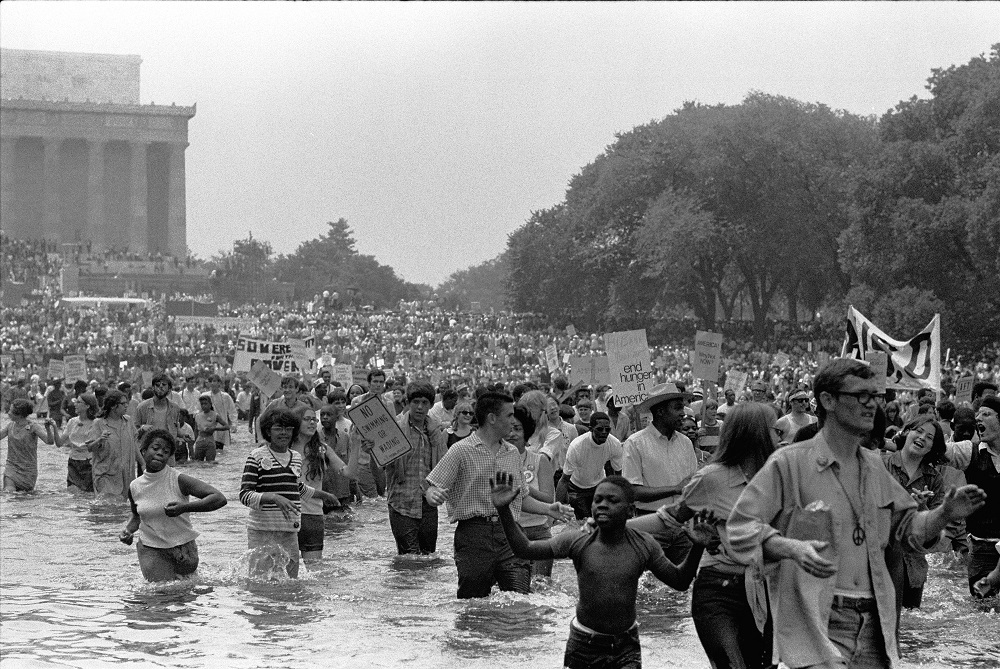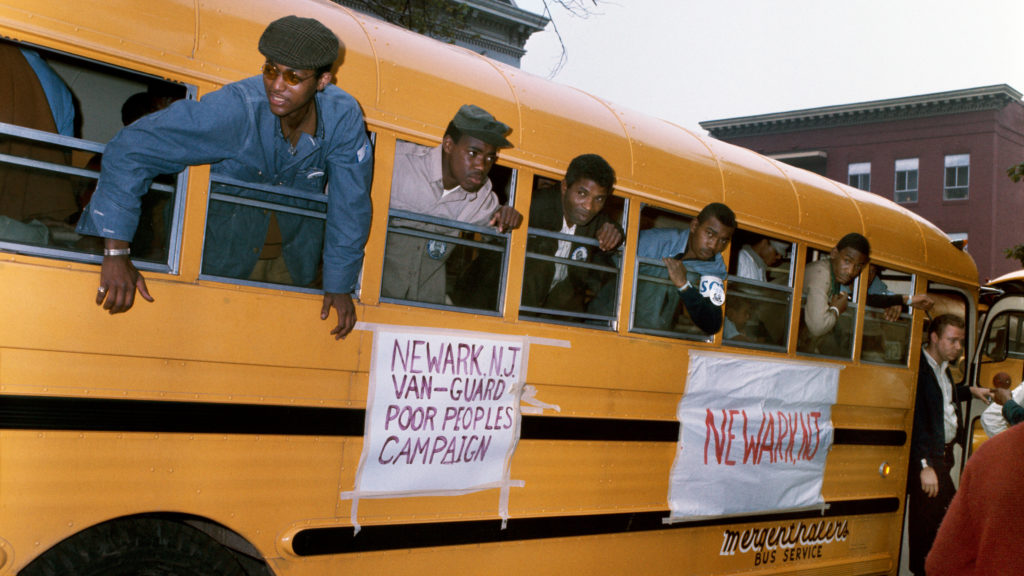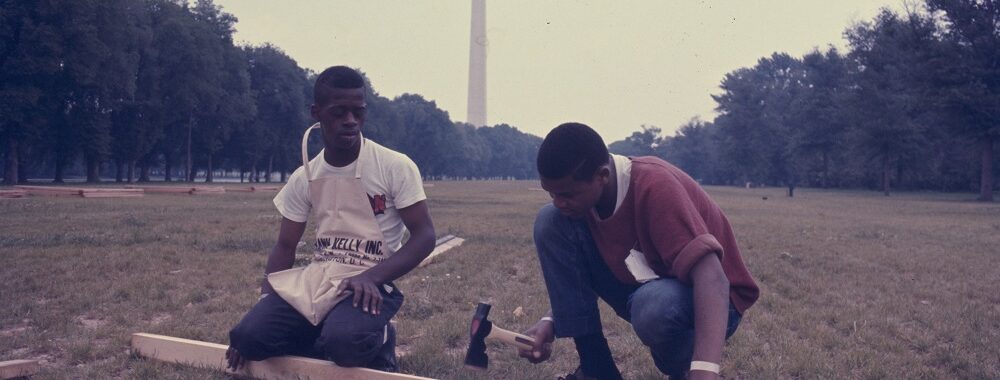New exhibition at the Freedom Center showcases 1968 campaign against poverty
Smithsonian traveling exhibition Solidarity Now! 1968 Poor People's Campaign opens March 30
CINCINNATI, OH (March 28, 2023) — Rev. Dr. Martin Luther King, Jr.’s most ambitious dream drew thousands to the National Mall in Washington, DC. It sparked a six-week protest and camp along the edge of the Reflecting Pool and implored leaders to take action on the growing divide in America. It united people across races, ethnicities and regions. It demanded an end to poverty.
The National Underground Railroad Freedom Center is illuminating the often-overlooked history of the multicultural movement to confront poverty that redefined social justice and activism in America. Solidarity Now! 1968 Poor People’s Campaign, organized by the Smithsonian Institution Traveling Exhibition Service (SITES) and the National Museum of African American History and Culture, opens Thursday at the Freedom Center.
In the 1960s, the United States emerged as a global model of wealth and democracy, an estimated 25 million Americans lived in poverty – nearly 13% of the population. From the elderly and underemployed to children and persons with disabilities, poverty affected people of every race, age and religion. In response, the Southern Christian Leadership Conference, led by the Rev. Dr. Martin Luther King, Jr., and Rev. Ralph Abernathy, organized the Poor People’s Campaign as a national human rights crusade. Solidarity Now! features photographs, oral histories with campaign participants and organizers and an array of protest signs, political buttons and audio field recordings collected during the campaign. 
“The civil rights movement of Dr. King is often thought of as a movement about race, but it was more. It was a movement about equity, about freedom – including freedom from hunger and want – for all people,” said Woodrow Keown, Jr. president and COO of the National Underground Railroad Freedom Center. “We’re proud to present Solidarity Now! to our community so we can show that equity was never about just some of us, but about all of us.”
Solidarity Now! explores the significance of the tactics and impact of the 1968 Poor People’s Campaign that drew thousands of people to build a protest community on the National Mall in Washington, D.C. For nearly six weeks they inhabited “a city of hope” on 15 acres between the Washington Monument and the Lincoln Memorial to call the nation’s attention to the crippling effects of poverty for millions of Americans. The protest site was called Resurrection City. Through a 3D map of Resurrection City, guests to Solidarity Now! can examine the planned spaces for housing, a cultural center, city hall, theater stage and essential services, including facilities for food and dining, sanitation, communications, education, medical and dental care and childcare.
As a multiethnic movement that included African Americans, Mexican Americans, Native Americans, Puerto Ricans, Asians and poor whites from Appalachia and rural communities, the six-week protest community in Washington attracted demonstrators nationwide. The campaign leaders presented demands to Congress, including demands for jobs, living wages and access to land, capital and healthcare. It was the first large-scale, nationally organized demonstration after King’s death in April earlier that year.
 “Three generations later and we are still fighting for these same rights,” added Keown. “Our poverty rate remains above 12%. We hope this exhibition may reinvigorate a generation to take up this banner so all people can enjoy equity of resources, access and care; so that we can ensure freedom for all.”
“Three generations later and we are still fighting for these same rights,” added Keown. “Our poverty rate remains above 12%. We hope this exhibition may reinvigorate a generation to take up this banner so all people can enjoy equity of resources, access and care; so that we can ensure freedom for all.”
The exhibition title is a reference to the Solidarity Day Rally held June 19, 1968, as a major highlight and capstone for the movement. The rally at the Lincoln Memorial featured speeches by celebrities, activists and campaign organizers as a continuation of the 1963 March on Washington for Jobs and Freedom.
Solidarity Now! 1968 Poor People’s Campaign will be open March 30 through June 19, 2023 at the Freedom Center – Smithsonian Affiliations institution. The exhibition is included with admission. For more information, visit freedomcenter.org/solidaritynow.
Solidarity Now! 1968 Poor People’s Campaign is supported by the CVS Health Foundation, a private foundation created by CVS Health to help people live healthier lives.
Solidarity Now! 1968 Poor People’s Campaign is based on City of Hope: Resurrection City & the 1968 Poor People’s Campaign, which was organized by the National Museum of African American History and Culture and on view at the National Museum of American History from December 15, 2017 to February 3, 2019.
###
About the National Underground Railroad Freedom Center
The National Underground Railroad Freedom Center opened in August 2004 on the banks of the Ohio River in downtown Cincinnati, Ohio. Since then, more than 1.3 million people have visited its permanent and changing exhibits and public programs, inspiring everyone to take courageous steps for freedom. Two million people have utilized educational resources online at freedomcenter.org, working to connect the lessons of the Underground Railroad to inform and inspire today’s global and local fight for freedom. Partnerships include Historians Against Slavery, Polaris Project, Free the Slaves, US Department of State and International Justice Mission. In 2014, the National Underground Railroad Freedom Center launched a new online resource in the fight against modern slavery, endslaverynow.org.
About SITES and Smithsonian Affiliations
The Smithsonian Institution Traveling Exhibition Services (SITES) and Smithsonian Affiliations are critical national outreach units at the Smithsonian Institution. For more than 70 years, SITES has been connecting Americans to their shared cultural heritage through a wide range of exhibitions about art, science, and history. Smithsonian Affiliations establishes and maintains the Smithsonian’s long-term partnerships with museums, educational organizations, and cultural institutions in the U.S., Puerto Rico, and Panama. Together, SITES and Affiliations share the Smithsonian’s vast resources with millions of people outside Washington, D.C. Visit sites.si.edu and affiliations.si.edu for more information.
About the National Museum of African American History and Culture
Since opening Sept. 24, 2016, the National Museum of African American History and Culture in Washington, D.C., has welcomed more than 7 million visitors. The nearly 400,000-square-foot museum is the nation’s largest and most comprehensive cultural destination devoted exclusively to exploring, documenting, and showcasing the African American story and its impact on American and world history. For more information about the museum, visit nmaahc.si.edu and follow @NMAAHC on Twitter, Facebook, and Instagram.
